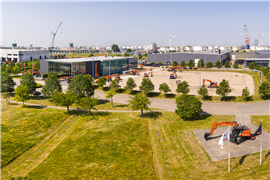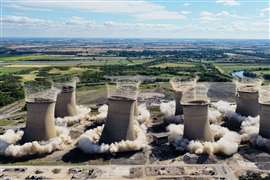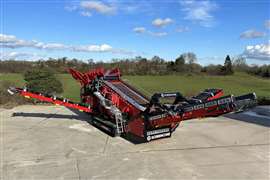India’s biggest demolition project
28 September 2022
India’s biggest demolition project, the Supertech Twin Towers in Noida, Utter Pradesh near the capital New Delhi is a spectacular feat of precision demolition.
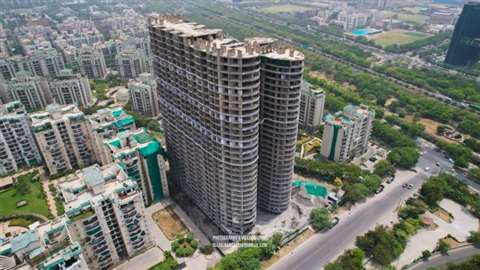 A birds eye view of the the Apex and Cayenne towers. (Photo: Jet Demolition)
A birds eye view of the the Apex and Cayenne towers. (Photo: Jet Demolition)
It is among the 15 tallest buildings in the world to be demolished in a controlled implosion and took place at 2.30 pm on Sunday 28 August.
The project was a collaboration between Edifice Engineering, a demolition company based in Mumbai, and Jet Demolition of South Africa, marking the second time that the two companies have collaborated in India.
The first was in January 2020, when three high-rise structures were imploded within 24 hours.
“What makes Apex unique is that not only is it the tallest building ever to be imploded in India, but also one of the top 15 tallest buildings to be imploded globally,” said Jet Demolition director Joe Brinkmann.
Why were the Supertech Twin Towers demolished?
The successful implosion of the Apex (103 m, 337 ft) and Cayenne towers (97 m, 318 ft) followed the India’s Supreme Court ruling ordering the illegal structures to be demolished, which were originally planned to top out at 40 + 3 storeys.
What made the implosion even more impressive was that the twin towers had to be brought down in a densely populated residential area such as Noida’s Sector 93A. Here the adjacent building was a mere 9 m (29 ft) away.
“India is a vibrant democracy where all voices are heard and concerned citizens express their anxieties vigorously. They do not hesitate to embark on litigation to challenge big business when necessary to correct flouting of building regulations. More corrective actions are expected in future,” adds Joe.
It was a protracted nine-year court process initiated by nearby residents to have the Supertech Twin Towers removed. Eventually the Supreme Court decreed that the demolition proceed rapidly.
However, it remained involved in the leadup to the implosion, receiving feedback from all stakeholders and providing updated instructions as the project progressed.
How was the demolition planned?
The Supreme Court appointed the CSIR-CBRI and CSIR-CIMFR to scrutinise, critique and directly oversee all implosion plans and to carry out detailed monitoring of the environmental effects of blasting.
All technical details and protective measures had to comply with set requirements, including the strategy and tactics for all protective measures for the surrounding buildings.
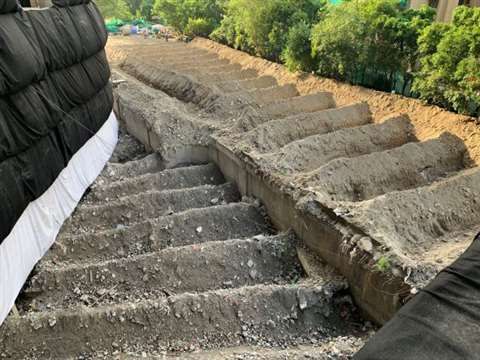 Impact cushions were installed on the site. (Photo: Jet Demolition)
Impact cushions were installed on the site. (Photo: Jet Demolition)
This was to avoid a stand-up event and ensure the desired collapse behaviour of the buildings while causing no structural damage to the surrounding buildings, the closest having major structural defects due to poor construction practice.
All nearby buildings were draped with geotextile fabric curtains to minimise window breakage from any fine spray of pulverised concrete from the blasting.
The detailed planning and implosion preparation was especially challenging due to the proximity of the towers to neighbouring buildings, in addition to their robust construction, able to withstand high-magnitude earthquakes.
Test blasting revealed that unusually high explosive loading was required to reliably fail the shear walls. “These shear walls fell into the class of ‘highly unforgiving’ when it came to attempts at explosive-driven rupture,” said Joe.
Up to 10 m (32 ft) long, the shear walls had heavy overlapping box stirrups at 100 mm intervals around the vertical bars, forming an incredibly strong rebar cage with a load capacity of 565 MPa to 662 MPa provided by the steel alone, excluding the concrete.
This made them highly resistant to rupture by blasting. Due to the rebar alone, the individual walls had a load capacity of up to 1.7 t.
How were the towers demolished?
A total of 17,000 m of holes were drilled, while 3.5 t of explosives was needed to successfully fell the structures.
This meant that the impact and potential for structural damage to surrounding buildings was a significant concern.
There was heightened anxiety among authorities and stakeholders that the adjacent building at a mere 9 m (29 ft) away, beset with structural degradation, would be further weakened and collapse from implosion-induced vibration.
Dozens of columns were strengthened, beams were back-propped, and an array of crack gauges was installed to monitor prominent structural cracks – but no movement or crack growth was induced by the implosion.
Nearby buildings were draped with geotextile curtains to minimise window breakage. “Minimal superficial impact, with a small number of windows cracked, and an 8 m (26 ft) section of brick boundary wall to contend with after the implosion, is an extremely satisfying result,” said Joe.
At peak, over 400 persons prepared the building for implosion, many of whom had families and their own residences within close proximity to the Supertech Twin Towers.
“Despite being nervous about the implosion we and our partner Edifice Engineering were welcomed and supported by the local community, who entrusted their homes and livelihoods to us,” said Joe.
The post-demolition clean up operation
Prior to implosion, the surrounding structures housing over 5,000 residents were temporarily evacuated, with the support of a 650-person police presence.
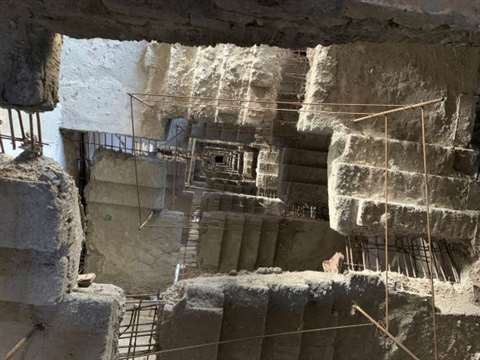 The stairs were pre-weakened prior to the demolition. (Photo: Jet Demolition)
The stairs were pre-weakened prior to the demolition. (Photo: Jet Demolition)
As for clean-up operations, the intention is to recycle all materials resulting from the implosion. Over 68,000 t of concrete rubble are expected to be crushed and reused, with liberated rebar sent to foundries for recycling.
A large portion of the project cost is being recovered from the sale of the rebar, indicative of exactly how strong these buildings were. Clean-up and recycling operations are being led by Edifice Engineering, with an anticipated completion date of December 2022.
Citing the project as one of the most challenging ever undertaken by either Edifice Engineering or Jet Demolition, Joe concludes: “Edifice Engineering and India have joined the 100 m implosion club under extremely demanding conditions.”
CONNECT WITH THE TEAM







